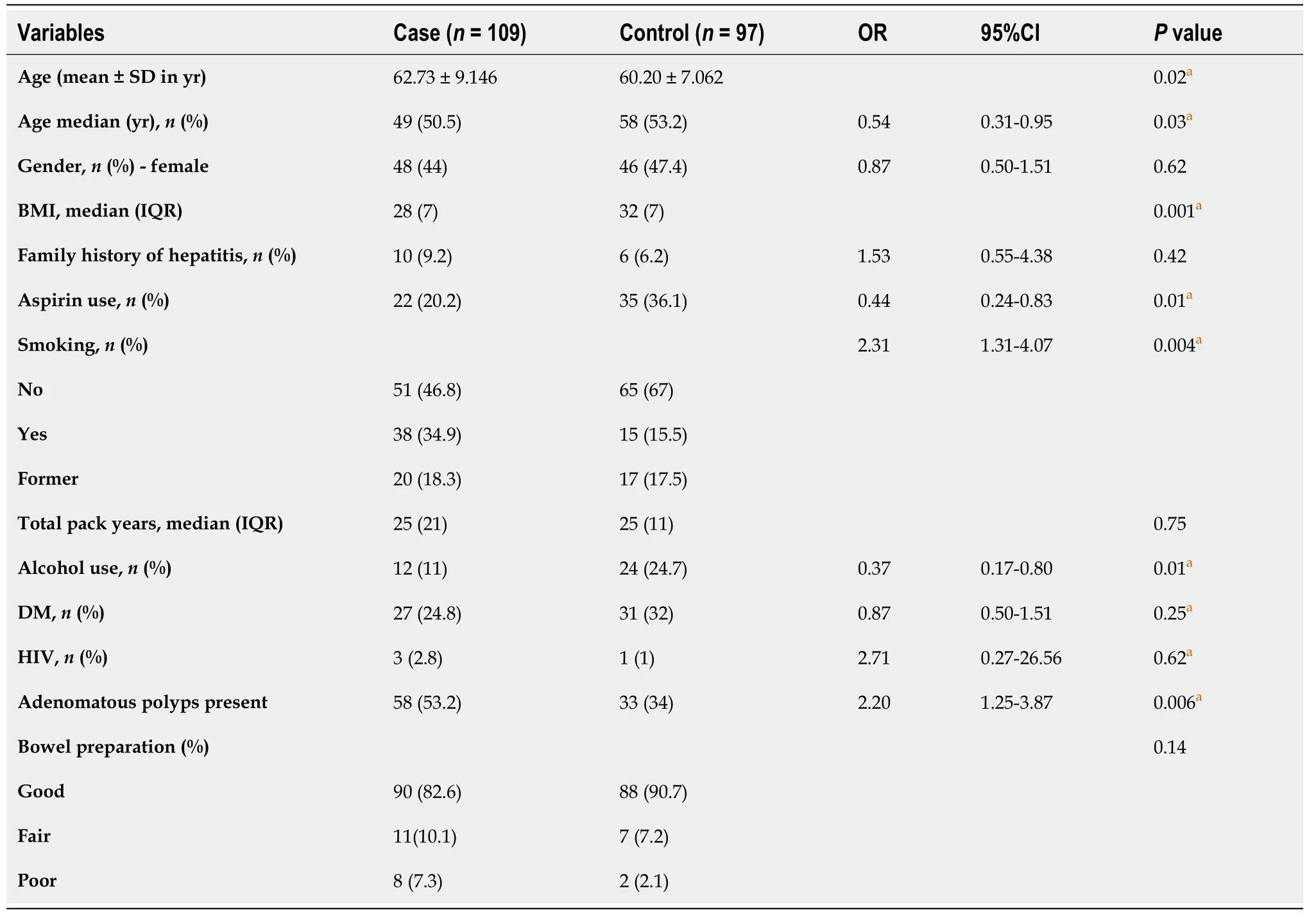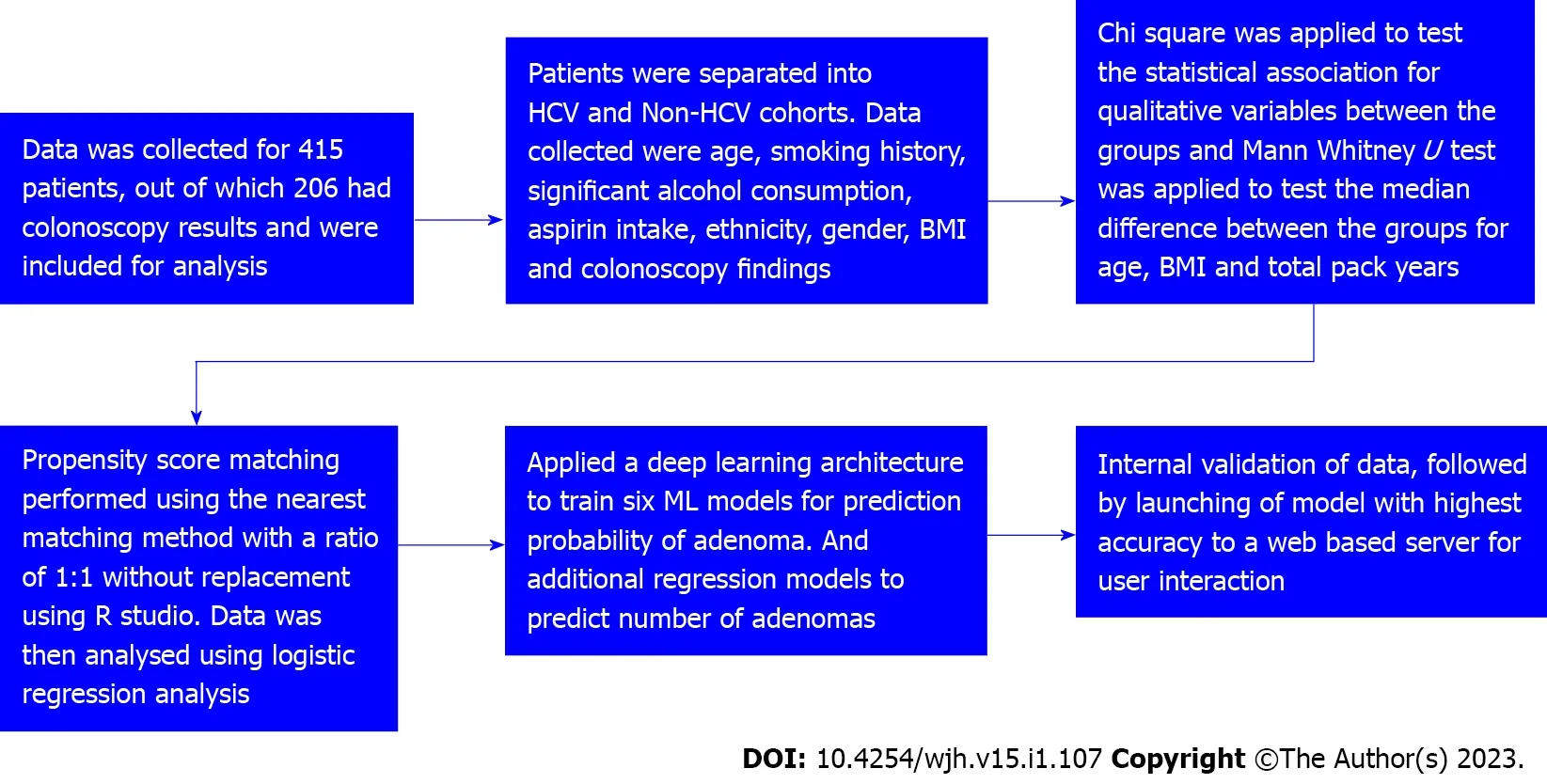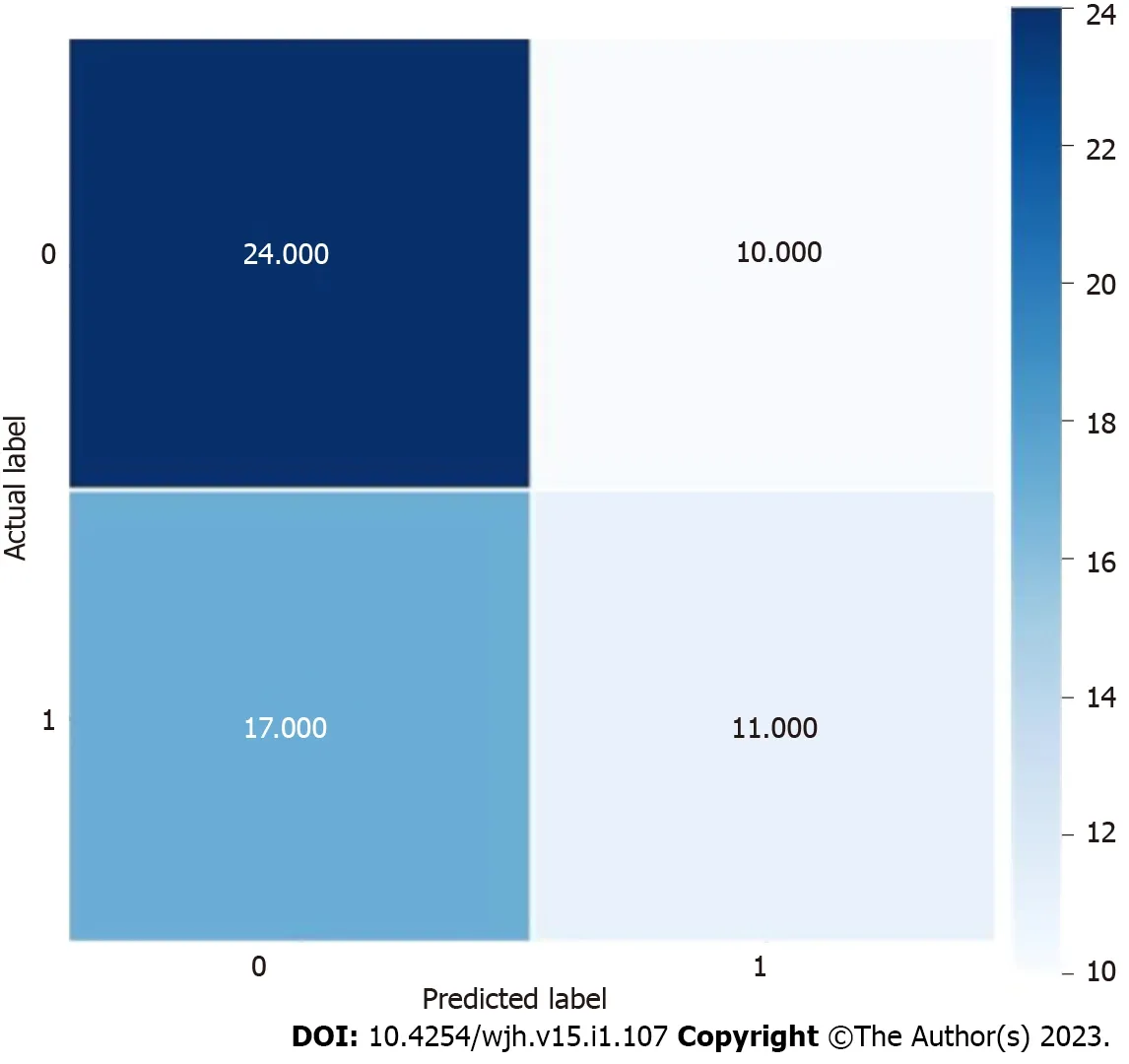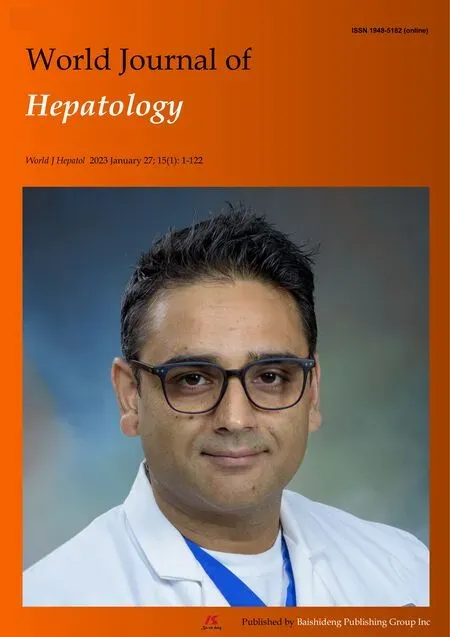Detection of colorectal adenomas using artificial intelligence models in patients with chronic hepatitis C
2023-03-18YuvarajSinghMayaGogtayAnuroopYekulaAakritiSoniAjayKumarMishraKartikeyaTripathiGMAbraham
Yuvaraj Singh,Maya Gogtay,Anuroop Yekula,Aakriti Soni,Ajay Kumar Mishra,Kartikeya Tripathi,GM Abraham
Yuvaraj Singh,Anuroop Yekula,Aakriti Soni,Department of Internal Medicine,Saint Vincent Hospital,Worcester,MA 01608,United States
Maya Gogtay,Hospice and Palliative Medicine,University of Texas Health-San Antonio,San Antonio,TX 78201,United States
Ajay Kumar Mishra,Division of Cardiology,Saint Vincent Hospital,Worcester,MA 01608,United States
Kartikeya Tripathi,Division of Gastroenterology and Hepatology,UMass Chan School-Baystate Medical Center,Springfield,MA 01199,United States
GM Abraham,Division of Infectious Disease,Chief of Medicine,Saint Vincent Hospital,Worcester,MA 01608,United States
Abstract BACKGROUND Hepatitis C virus is known for its oncogenic potential,especially in hepatocellular carcinoma and non-Hodgkin lymphoma.Several studies have shown that chronic hepatitis C (CHC) has an increased risk of the development of colorectal cancer(CRC).AIM To analyze this positive relationship and develop an artificial intelligence (AI)-based tool using machine learning (ML) algorithms to stratify these patient populations into risk groups for CRC/adenoma detection.METHODS To develop the AI automated calculator,we applied ML to train models to predict the probability and the number of adenomas detected on colonoscopy.Data sets were split into 70:30 ratios for training and internal validation.The Scikit-learn standard scaler was used to scale values of continuous variables.Colonoscopy findings were used as the gold standard and deep learning architecture was used to train six ML models for prediction.A Flask (customizable Python framework) application programming interface (API) was used to deploy the trained ML model with the highest accuracy as a web application.Finally,Heroku was used for the deployment of the web-based API to https://adenomadetection.herokuapp.com.RESULTS Of 415 patients,206 had colonoscopy results.On internal validation,the Bernoulli naive Bayes model predicted the probability of adenoma detection with the highest accuracy of 56%,precision of 55%,recall of 55%,and F1 measure of 54%.Support vector regressor predicted the number of adenomas with the least mean absolute error of 0.905.CONCLUSION Our AI-based tool can help providers stratify patients with CHC for early referral for screening colonoscopy.Along with providing a numerical percentage,the calculator can also comment on the number of adenomatous polyps a gastroenterologist can expect,prompting a higher adenoma detection rate.
Key Words: Machine learning;Calculator;Artificial intelligence;Hepatitis C;Screening
INTRODUCTION
Hepatitis C is the most common blood-borne infection worldwide despite being gravely underdiagnosed[1,2].Data from the National Health and Nutrition Examination Survey 2013-2016 and four other high-risk populations;homeless,incarcerated,active-duty military,and nursing homes estimates that approximately 4.1 million persons in the United States (approximately 1.7% of the population) were hepatitis C virus (HCV) antibody-positive indicating past exposure and 2.4 million persons (approximately 1% of the population) were HCV RNA positive indicating an active infection[3].
Although HCV is thought of as a primary disease of the liver,it has a wide array of extrahepatic manifestations,including skin,blood,lymphatic and intestinal pathologies[4,5].The United States Chronic Hepatitis Cohort Study showed an increased incidence of rectal cancer with increased mortality in chronic HCV,but not colon cancers[4-6].Colorectal cancer (CRC) is the third most commonly diagnosed cancer and the second most common cause of cancer-related death worldwide[3,7].
The current gold standard for diagnosing CRC is colonoscopy.The United States Preventive Services Task Force,American College of Gastroenterology,and American Cancer Society recommend screening for CRC starting at age 45 years in average-risk individuals[8-10].There are no specific screening guidelines for CRC in patients with hepatitis C,despite there being an increased association.
Importance of artificial intelligence
Artificial intelligence (AI) is the new silk road.It is a technique that allows machines to store large amounts of data from various sources,process them accurately,reason,and even simulate human intelligence to provide a plan for clinical treatment.AI has augmented medical research on an enormous scale in recent years and continues to do so.It has significantly helped reduce the workload of clinicians and healthcare staff[11].
There are multiple facets of AI used in gastroenterology such as convolutional neural network(CNN),deep learning (DL),machine learning (ML),and computer-aided design (CAD)[12].ML is a subset of AI,DL is a subset of ML and neural networks make up the backbone of DL algorithms.Multiple AI-assisted systems such as EndoBRAIN CAD by Kudoet al[13] and a CNN-based auxiliary model by Dinget al[14] have been used to detect and diagnose bowel pathologies including colonic adenomas and neoplasms with higher sensitivity and specificity as compared to trained endoscopic experts[13,14].
ML is one of the subsets of AI where algorithms are trained for specific tasks.This is being increasingly used in modern medicine for analyzing large volumes and complex data.ML can be applied in any clinical setting to include mathematical and statistical assumptions that are unfamiliar to most clinicians.It can be performed in a two-step process.Firstly,the clinical question.Secondly,which factors in the clinical question/process can be optimized.Data management is another aspect of ML that is crucial.The availability of high-quality data can train the ML algorithms and avoid data bias and errors that can erroneously skew the results.
The use of AI has shown an increase in both polyp detection rate and adenoma detection rate (ADR)which are the primary colonoscopy quality indicators.Each 1% increase in ADR leads to an approximately 3% decrease in the future risk of cancer[15].As timely intervention in the form of screening colonoscopy can help detect pre-neoplastic or early stages of CRC[15],it is imperative to develop a tool that can help clinicians distinguish which patients with chronic hepatitis C (CHC) infection require early referral for colonoscopy.Rustagiet al[16] in a case-control study showed a significantly higher number of adenomas detected on screening colonoscopy in the CHC group.In addition,building an ML model which can help predict the expected number of adenomas can reduce missed adenomas,decreasing subsequent cancer and the overall burden of CRC on healthcare.This is the aim of our research in developing an AI/ML-based tool.
MATERIALS AND METHODS
Study design and setting
This observational study with cross-sectional data collection and analysis was conducted at a community hospital in Massachusetts,USA.The institutional review board approved the study.The results were tabulated and statistically analyzed using computer software (SPSS version 25 for Windows,SPSS Inc.,Chicago,IL,USA).Descriptive statistics for continuous variables were calculated with the Mann-WhitneyUtest,and categorical variables were calculated with the Chi-square test.The level of significance was set atP<0.05.
Model training: Classification
Several ML models were trained and tested,and the model that could predict percentage probability with the highest accuracy was saved for the deployment stage.
Training and testing dataset characteristics
The dataset used to train and test the ML algorithms was collected manually and stored in a commaseparated file format.The dataset contained several attribute vectors from 415 patients [i.e.,sex,age,body mass index (BMI),obesity class,oral contraceptive use,significant alcohol use,hypothyroidism,intravenous drug use,diabetes mellitus,human immunodeficiency virus,concomitant statin use,controlled attenuation parameter (CAP) grade,HCV status,genotype,aspartate aminotransferase,alanine aminotransferase,platelet count,hemoglobin A1c,and triglycerides].Some patients had missing data,which were replaced by zeros for training and testing.The task was to predict the percentage probability of adenoma occurrence in colonoscopy,followed by calculating the number of polyps.For this purpose,two ML models,i.e.,classification and regression models,were trained,and the best models were saved from both ML categories.
Preprocessing
The dataset was loaded onto a pandas DataFrame.The output label was colorectal adenomatous polyps.Numerical feature vectors were replaced with categorical variables.Categorical attributes such as HCV genotype and gene polymorphisms underwent label encoding.The variables with numerical values were scaled using the scikit-learn StandardScaler function to scale down to the desired range of 0-1.The complete dataset was split into a 70:30 ratio,in which 70% of the total dataset was used for training.The remaining 30% of the entire dataset was used to test internal validity and select the ML model with the highest predictive value.
ML algorithm internal testing
Several ML algorithms were trained to predict hepatic steatosis and CAP grades using the above-listed vectors.These models included: Support vector classifier,random forest,Bernoulli naïve Bayes (BNB),Gradient boosting classifier (GBC),logistic regression,and stochastic gradient descent classifier.All models were trained using 70% of the dataset.After training,each model was tested using the remaining 30% of the dataset The model with the highest testing accuracy,the GBC model,was chosen for external validity testing.
GBC model
The GBC model is a set of ML algorithms that additively combines multiple weaker ML models to produce a final predictive model.Our model assigned a binary classification to datasets and used multiple regressions along several decision trees to refine its attempts to predict the steatosis classification correctly.The model graded each attempt on a loss function which evaluates the extent to which the previous tree was inaccurate.
RESULTS
Patients were divided into cases (HCV) and controls (non-HCV).Data was tabulated as described in Table 1.Figure 1 is a strobe diagram with an overview of the methodology and results.The performance of different ML algorithms for training and testing to detect colorectal adenomatous polyps is shown in Table 2.
Using the colonoscopy results determined by the pathology of the biopsied polyp as the output,we applied a DL architecture using the above variables to train and test several ML models using a 415-patient dataset.As shown in Table 2,our results demonstrated that the BNB model had the highest testing accuracy (56%),precision (55%),recall (55%),and F1 score (54%).The distribution of actual and predicted labels during internal testing can be seen in Figure 2.As depicted in Table 3,our results demonstrated that the support vector regressor model had the lowest mean absolute error - 0.905,indicating it was the most suitable ML model to calculate an approximate number of polyps.
Application development phase
A flask-based web app was developed using the model with the highest accuracy for the application phase.A flash application programming interface (API) was used to deploy the trained ML model as a web application.The web-based API was then deployed into a web server using Heroku,a cloud application platform (https://adenomadetection.herokuapp.com/).
DISCUSSION
The initial analyses of the variables have demonstrated that median age of 62 years,with higher BMI,smoking,alcohol use,and concomitant aspirin use are related to adenoma detection with statistical significance among the data collected from patients with CHC who underwent colonoscopies.Using these initial datasets,DL architecture was used to train six ML models,which were prepared and validated using a 70:30 ratio of the dataset.Of the multiple models,the BNB model predicted the probability of adenoma detection with the highest accuracy,precision,and recall.Flask API was used to deploy the ML model,and Heroku web API was used to develop the AI tool.The model training and performance are shown in Tables 2-4.
The AI tool may be useful in the clinical setting to triage patients with hepatitis C,who have not received a formal CRC screening to stratify them into high-risk and low-risk groups.This can guide the gastroenterologist during the colonoscopy to help increase the ADRs.This knowledge of the increased risk of CRC incidence in hepatitis C and isolating patients that are high risk can prompt physicians to start CRC screening early and more frequently in these specific subsets.
Although multiple review articles have been published,there are very few clinical studies.To our knowledge,this is one of two retrospective analyses performed comparing CRC in hepatitis C and nonhepatitis C individuals.One of the main limiting factors was that the study was performed in the patient population that visited the primary care clinic at a community hospital in a single city in the northeast United States;it is limited by the geographical and socioeconomic aspects of the patient population.Analysis and validation were carried out on this limited sample size.Another drawback was that the study was primarily a retrospective analysis.Timing of the colonoscopy and the patient having active hepatitis infection might not always be documented,and timing was not specific in many patients,which limited the sample size that was analyzed.
AI application to healthcare has been increasingly pursued in the past decade,changing how we deliver advanced patient care[17,18].AI and ML ensure the automation of many time-consuming activities and provide better insight into patient data that are not evident to providers[17].Although the hype behind AI is promising,various barriers prevent the real-world application of these new AI systems.AI has helped in increased interoperability of extensive data,reasonable data-driven decisions involving evidence-based medicine,and hence a higher quality of care.
CRC is a commonly diagnosed malignancy in men and women with increasing mortality[19].Many epidemiological studies have shown a positive association of CHC infection with extra-hepatic malignancies,especially gastrointestinal malignancies[16,19].Our study focused on this positive association between CHC and CRC and on using AI and ML models to further ease the diagnosis in these patient populations.

Table 1 Patient demographics

Table 2 Machine learning model training
AI is integrated into our everyday life to such an extent that we barely remember what life was before it.This includes face recognition to unlock our phones,self-driven cars,chatbots for almost every business,and even ML-based financial fraud detection.AI-driven models are increasingly utilized to screen,diagnose and monitor multiple clinical conditions.Many AI algorithms have been used in CRC detection.Huet al[20] performed ML simulations using S-Kohonen,Backpropagation and SVM neural networks,showing the S-Kohonen method’s effectiveness for colon cancer classification[20].
Zhanget al[21] derived a cost-effective and sensitive method for detecting BRAF mutations in CRC using a counter propagation artificial neural network to distinguish mutant BRAFvswild type[20,21].Many such ML models are increasingly being utilized in precision oncology to precisely guide diagnosis and management decisions in CRC patients[19-21].

Table 3 Machine learning models and their mean absolute error

Table 4 Machine learning models and their performance

Figure 1 Strobe diagram.
AI tools will potentially transform our practice by leveraging massive amounts of data to personalize care to the right patient,in the right amount,at the right time.These novel tools assist physicians in the detection and early diagnosis of pre-malignant and malignant lesions in general and high-risk populations.
CONCLUSION
Our AI tool can be further modified based on the treatment of hepatitis C with the new direct-acting antivirals,and how treated and cured hepatitis C alters the incidence of CRC in these groups.Long-term prospective studies,including a subgroup analysis between patients cured of hepatitis C,who had a relapse of the disease,and who refused or were untreated and how it affected CRC detection,would help guide diagnostics.Further validation with randomized controlled trials and multicenter participation will ensure replicability and repeatability of the results for the smooth incorporation of such AI-based tools into clinical practice[19-22].

Figure 2 Distribution of actual label vs predicted label during internal testing.
ARTICLE HIGHLIGHTS
Research background
Several studies have shown that chronic hepatitis C virus (HCV) increases the risk of developing colorectal cancer (CRC).We conducted a study to analyze this positive relationship.We developed an artificial intelligence (AI) based tool using machine learning (ML) algorithms to stratify these patient populations into risk groups for CRC/adenoma detection.
Research motivation
We acknowledge the increased applications of AI with ML in medicine.Gastroenterology and hepatology have immense potential for AI integration.Hence,to develop an AI automated calculator,we applied ML to train models to predict the probability and the number of adenomas detected on colonoscopy.
Research objectives
Our objective was the create a readily available AI tool in the form of a calculator that healthcare providers throughout the globe can access to predict the prevalence of adenoma/CRC.
Research methods
We used colonoscopy findings as the gold standard and applied a deep learning architecture to train ML models for prediction.The institutional review board approved the study.
Research results
Data on 415 patients were collected.We discovered a higher incidence of adenoma/CRC in patients with chronic HCV in the untreated patient population.On internal validation,the Bernoulli naive Bayes ML model showed the highest predictive accuracy and recall for adenoma detection rates.
Research conclusions
Our AI-based tool shows an association between HCV and colorectal adenomas.This tool can help providers stratify their patients at increased risk of CRC and prompt early referral for colonoscopy.
Research perspectives
In the future,we would like to see this calculator being used in clinical practice as a preventative measure to increase early diagnosis of high-risk adenomas/CRC.
FOOTNOTES
Author contributions:Singh Y and Gogtay M contributed to the conceptual design of the study;Singh Y,Gogtay M,Yekula A,and Soni A independently screened the medical records and extracted the data;Tripathi K conducted the statistical analysis;Singh Y,Gogtay M,Yekula A and Soni A contributed to the write-up and submission of the study;Tripathi K,Mishra AK,and Abraham G reviewed the final manuscript;and all authors reviewed and agreed the final content of the article.
Institutional review board statement:We obtained approval from the joint institutional review board at MetroWest Medical Center (IRB#2021-035) before initiation and complied with the study protocol.The IRB waived the requirement of consent from study participants.
Informed consent statement:The institutional review board waived the requirement of consent from study participants.
Conflict-of-interest statement:All the authors report no relevant conflicts of interest for this article.
Data sharing statement:No additional data are available.
STROBE statement:The authors have read the STROBE Statement-checklist of items,and the manuscript was prepared and revised according to the STROBE Statement-checklist of items.
Open-Access:This article is an open-access article that was selected by an in-house editor and fully peer-reviewed by external reviewers.It is distributed in accordance with the Creative Commons Attribution NonCommercial (CC BYNC 4.0) license,which permits others to distribute,remix,adapt,build upon this work non-commercially,and license their derivative works on different terms,provided the original work is properly cited and the use is noncommercial.See: https://creativecommons.org/Licenses/by-nc/4.0/
Country/Territory of origin:United States
ORCID number:Yuvaraj Singh 0000-0003-4970-8870;Maya Gogtay 0000-0001-9955-7121;Anuroop Yekula 0000-0002-3564-4901;Aakriti Soni 0000-0001-9732-2898;Ajay Kumar Mishra 0000-0003-4862-5053;GM Abraham 0000-0003-4296-8362.
S-Editor:Wang JJ
L-Editor:Webster JR
P-Editor:Wang JJ
杂志排行
World Journal of Hepatology的其它文章
- Liver immunity,autoimmunity,and inborn errors of immunity
- Clinical characteristics and outcomes of COVID-19 in patients with autoimmune hepatitis: A population-based matched cohort study
- Influence of non-alcoholic fatty liver disease on non-variceal upper gastrointestinal bleeding: A nationwide analysis
- Rising incidence,progression and changing patterns of liver disease in Wales 1999-2019
- Prognostic role of ring finger and WD repeat domain 3 and immune cell infiltration in hepatocellular carcinoma
- Acute-on-chronic liver failure in patients with severe acute respiratory syndrome coronavirus 2 infection
